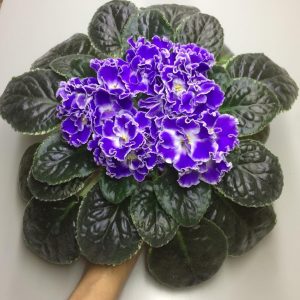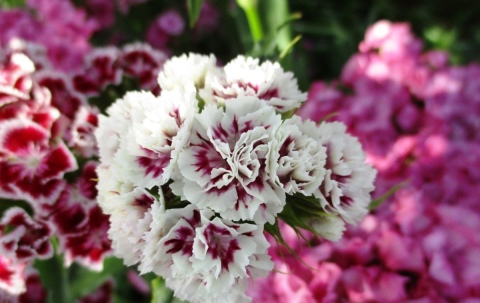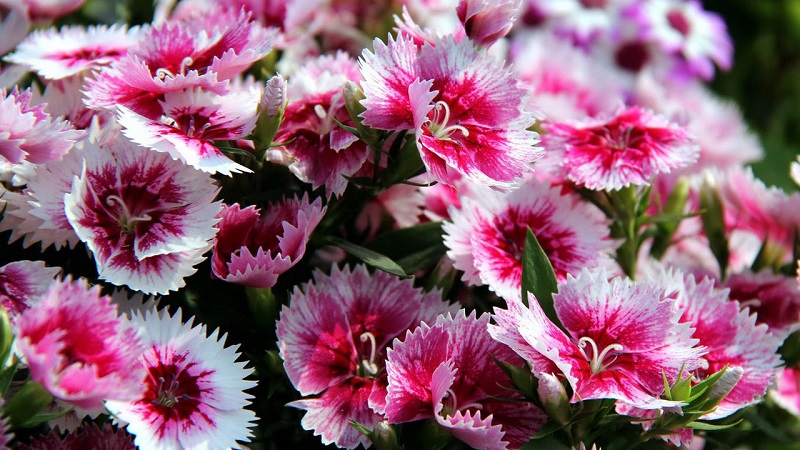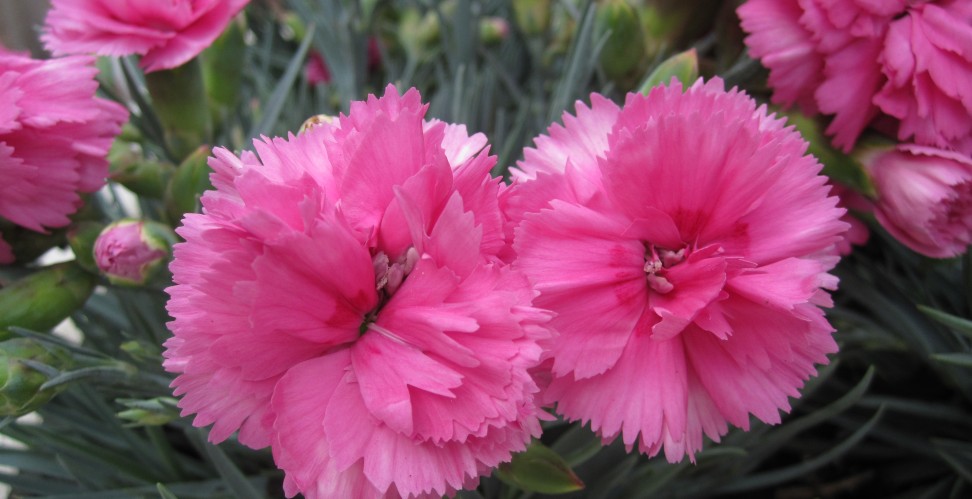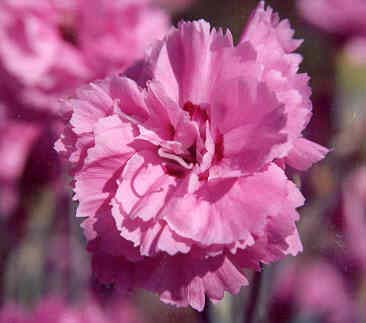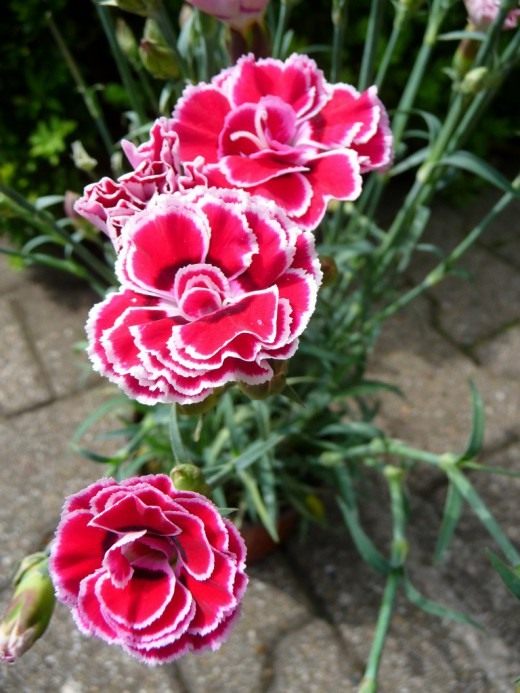Plant care
Carnation herbaceous variety Arctic Fire
Growing in natural conditions on sparse stony and sandy soils, resistant to heat and frost, herbal carnation does not require special care in a flower garden. However, this can only be fully attributed to adult, strong bushes.
Saplings and seedlings of carnations are more picky, get sunburn, are susceptible to fungal diseases, they are easily drowned out by weeds
When caring for crops, it is important to timely moisten the soil, remove weeds and destroy the crust.
In dry weather, the grass bushes, with its superficial root system, will gratefully respond to watering, but in general they tolerate a lack of moisture well. When grown in one place for several years, from the second year in spring, the carnation is fed with a complex mineral fertilizer to obtain a more generous and bright flowering.
At the end of summer, faded flowering shoots are shortened, which makes the bushes neat and attractive. In winter, the cloves are spud and covered with light materials - dead wood, spruce branches, wicker baskets or mats, this will prevent loose soil from blowing out and retain snow. With the onset of the first spring thaws, the cloves are opened and, as soon as the weather permits, the ground is fluffed.
Diseases and pests
A resistant plant is rarely affected by fungal diseases, but weak seedlings when grown in high damp greenhouses can be exposed to alternaria and rust. In the open ground, pests damage the carnation - caterpillars and slugs eat up young leaves, the root system is susceptible to attack by nematodes, in hot August, the bushes are inhabited by a spider mite.
Alternaria is characterized by the appearance on the leaves and stems of oblong grayish-brown spots with a dirty bloom. Small brick-red or orange bumps on the leaves indicate infection of the clove with a dangerous fungal infection - rust.
Leaves and twigs in Alternaria spots are destroyed; in case of severe damage, the entire plant is removed. Bushes with signs of rust are dug up and burned, plantings and soil in both cases are treated with fungicides (copper oxychloride, Fundazol, Maxim, Fitosporin-M).
Young shoots of carnations eat up caterpillars of cabbage scoops, slugs, wood lice. Caterpillars are harvested by hand, treated with infusions of onions, garlic, wormwood or insecticides (Decis, Arrivo, Fitoverm). The same drugs will help with the defeat of aphids and thrips.
When soil is infected with nematodes and wood lice, Agrozin or systemic insecticides are used to water the ground under the bushes. Slugs are destroyed with the help of Mesurol, in addition, these pests cannot tolerate copper-containing preparations, therefore, treatment with copper oxychloride against fungi will help ward off slugs.
The hot summer is a fertile time for the development of the spider mite, which envelops the leaves with the thinnest cobwebs, sucks out the juice and causes wilting and death of the bushes. Cloves are treated with infusions of garlic, sulfur, or the drug Aldicarb is added to the soil.
The best varieties and hybrids
For decorative purposes, Chinese carnation has been grown for more than three hundred years, and during this time numerous attractive forms, spectacular varieties and hybrids have been obtained.
In amateur floriculture, special attention is paid to dwarf varieties with compact bushes reaching a height of 15-20 cm, which are characterized by lush flowering
The garden varieties of the Chinese Geddevig carnation with rounded bushes 30–35 cm high and large non-double or double flowers with a diameter of 5–6 cm are very popular.
Carousel (Merry Go-Round)

Chinese carnation variety Carousel (Merry Go-Round)
The joyful flowers of this dwarf variety of Chinese carnations will decorate a flower bed, look great in a hanging planter or flowerpot on the porch. Bushes are neat, up to 20 cm high with knotty stems and numerous flowers 5-6 cm in diameter, white with a scarlet center.
The cut edges of the petals and the shiny, shiny texture give the cute variety even more charm. Long bloom - from early July until autumn frosts.
Vorozheya

Chinese carnation variety of Vorozheya
A wonderful variation of the Geddevig carnation with densely branched light green stems, forming small bushes about 35 cm high. The plants are completely covered with double flowers 4–5 cm in diameter. Satin petals, crimson-black with a jagged edge and a bright white border.
The bloom is very generous, from July to October frosts. This is one of the best terry dark-colored varieties - very effective and unpretentious.
Diana F1 Crimson (Diana F1 Crimson)

Chinese carnation grade Diana F1 Crimson Picotee (Diana F1 Crimson Picotee)
A bright hybrid of Dutch selection is distinguished by large colorful flowers with a diameter of 7–8 cm, adorning a small neat bush 20–25 cm high. The petals are wide, rounded, open, deep red with a finely toothed edge. The flowering is luxurious - from the beginning of July to the dank autumn cold. This hybrid is a great choice for potting or border decoration.
In addition to the colorful Crimson form, the series includes many other attractive variations, of which the most interesting are:
- Diana F1 White (Diana F1 White) - snow-white with a split edge of the petals;
- Diana F1 Blueberry (Diana F1 Blueberry) - bright purple;
- Diana F1 Crimson Picotee (Diana F1 Crimson Picotee) - with corrugated dense pink-crimson petals;
- Diana F1 Scarlet - fiery red, catchy.
Grace F1 crimson

Chinese carnation grade Grace F1 Crimson (Grace F1 crimson)
Another stunning red hybrid from the same Dutch manufacturer Hem Genetics. Unlike the previous series, these plants are adorned with double, full flowers. Low bushes, growing, form dense borders or flowering lawns.
Plant height - 18-25 cm, flowers are very large, 6-8 cm in diameter, with a fringed edge. Form Grace F1 Crimson is characterized by flowers of a dense wine-red color with spectacular white stamens.
Other beautiful varieties are presented in the series:
- Grace F1 Salmon - salmon pink;
- Grace F1 Deep rose - raspberry pink;
- Grace F1 White - sparkling white.
Grace hybrid Chinese carnations are suitable for indoor cultivation.
You will find information about other interesting species and varieties of carnations in the article "Carnations - the best varieties and hybrids".
Description of the carnation plant and its flowering
The carnation family.
The description of the clove plant should begin with the fact that the Moluccan and other islands of Southeast Asia are considered the birthplace of the clove tree. This famous plant is cultivated in Brazil, East Africa, the Antilles, including Jamaica, and other tropical countries.
The scientific generic name comes from the Greek words "Di" - Zeus and "anthos" - "flower", which can be translated as "flower of Zeus", or "divine flower".
One of the English names for carnations is "gilly-flowers". Some believe that it comes from the French name for the clove spice, which has a scent similar to that of flowers, “clou de girofle”. But, according to another version, it is associated with the name of the month when the carnations are mainly in bloom. And in England, and here it is July (July). One way or another, but "July" flowers "with the smell of carnations" are a wonderful addition to any flower garden.
According to the flowering of carnations, there is the following classification.
Large-flowered (Sim) - it includes the Sim group and Mediterranean hybrids. The diameter of the flower is more than 7 cm. It is grown for one flower.
Branched large-flowered (blue multiflorous, or mini carnation) - SprayCarnation, MiniCarnation. Less terry cup will not crack. The diameter of the flower is about 5 cm. Some varieties of this group are more resistant to fusarium.
Branched small-flowered (blue mini-multi-flowered) - MiniSpray, MultifloraCarnation. Flower diameter about 3 - 4 cm. Good resistance to Fusarium in many varieties.
Branched microcarnation - MicroCarnation. The diameter of the flower is about 3 cm. It is resistant to fusarium.
Chinese greenhouse carnation - ChinesiniCarnation. The result of crossing the Chinese carnation with branched carnations. The diameter of the flower is 3 - 5 cm, the flowers are fragrant, with a pattern of a Chinese carnation. There are 2 - 3 flowers on the shoot (above).
Diantini - DiantiniCarnation. The result of crossing different groups of greenhouse carnations with a bearded carnation (Turkish carnation). The diameter of the flower is about 2 cm. The flowers are odorless, the color is one-color, but the edges of the petals are paler.
Potted Carnations - PotCarnation. Grown in pots with a diameter of 10 - 12 cm. Pinch 1 - 2 times. Flowering after 16 weeks.
The large-flowered carnation was obtained in 1924 by the American breeder V. Sim from English varieties of terry carnation. He created the first group of this carnation and the first variety of this group - WilliamSim.
The assortment of carnations is constantly updated with more productive, pest and disease resistant, early ripening varieties that are not damaged during transportation and remain in water for a long time. The core of the assortment is made up of red varieties, but there are pink, white, yellow and orange, purple and bicolor carnations.
CHINESE CLOVES
The variety of this flower is amazing. Its unpretentiousness and bright colors of long flowering - that's why the Chinese carnation has become very popular among flower growers. Chinese perennial carnation grows in a compact or spreading bush. The height of the bush is from 10 cm (dwarf varieties) to 50 cm. The stems are thin, smooth, with nodules characteristic of the carnation family. The flowers of the Chinese carnation are single, up to 5 cm in diameter (on average 2-4 cm). The structure of the flower, depending on the variety, can be double, semi-double or simple. The edging of the petals has a fringe or teeth. The bushes of the Chinese carnation bloom in white, pink, coral, raspberry, cherry blossoms. Some varieties combine several colors, diluting the base color with a darker or lighter edging and "eye". Chinese carnation is a perennial shrub flower. Numerous knotty shoots are covered with narrow leaves. Sometimes, due to their length, they curl slightly, which gives them a special decorative effect. Large buds are located at the tips of erect stems. They are usually solitary and are colored pink, white and burgundy. Petals are most often terry. The tips are serrated with unusual edging. Blossom in early June and bloom magnificently until early August.
Perennial Chinese carnation is a frequent visitor to summer cottages. Planting and growing Chinese carnations is easy. At the same time, the plant quickly takes root on almost any soil. These perennial flowers can be planted in flower beds, in mixborders, on alpine slides and ridges. They are used as border plants, thanks to their bright and variegated flowers, they look great against the backdrop of green lawns. Chinese perennial carnation is used in landscape design due to its decorative and unpretentious care.
In order for the plant to grow well, it is necessary to choose a drained area without stagnant moisture. Do not plant in lowlands; build a high bed if the groundwater is close. The Chinese carnation feels great on cultivated garden soil. Loamy soils are ideal. You can plant in an open sunny area and in partial shade - the flowering is equally lush.To support the flowering process, fertilization will not be superfluous. Add humus or compost before digging. In a strong shade, the plant is capable of producing a small number of buds per season, but this does not bear any special decorative effect. So that the plants do not interfere with each other, the optimal distance between them is 30 cm. The thickening of the plantings leads to poor air permeability, which can provoke disease. Water Chinese cloves regularly and in moderation. In extreme heat, water more abundantly, but do not allow moisture to stagnate. Periodically loosen the soil, remove weeds from the site.
In our climatic conditions, the Chinese perennial carnation winters quite well. In late autumn, cut the flower stems at a height of about 5 cm above the ground. To prevent carnation from freezing in severe frosts, cover it with peat, sawdust or fallen leaves. With the onset of spring, we remove the shelter.
Chinese carnation "Pink Kisses"
Dianthus 'Pink Kisses'
Chinese carnation Perfume Pinks "Romance"
Dianthus Perfume Pinks "Romance"
Flowers with wavy petals, salmon pink with a carmine eye, diameter 4cm. Height 20 cm, width 15-20 cm. Leaves form a dense hummock, very large flowers up to 4 cm in diameter with carved edges, the inflorescence is simple, the range of colors is striking in its variety, abundant flowering.
Chinese carnation "Sunflower Jaguar"
The bush is compact, 10-15 cm high and 15-20 cm wide. The flowers are double, purple-red, 3-6 cm in diameter. It blooms from spring to autumn. For continuous and long flowering, it is recommended to remove faded flowers.
Chinese carnation "Esta"
The bush is compact, 10-15 cm high and 15-20 cm wide. The flowers are double, dark burgundy - brown core turns into a red-crimson shade of petals; diameter 3-6 cm.
Chinese carnation "Red Esta"
The bush is compact, 10-15 cm high and 15-20 cm wide. The flowers are double, the maroon core turns into a dark crimson shade of the petals; diameter 3-6 cm.
Varieties and varieties
Low-growing carnations are perennial herbaceous plants, which are represented by a huge variety of varieties and species. There are more than two dozen varieties of this plant, however, the most common 5. They, in turn, have a fairly extensive subspecies and varietal classification. In general, all varieties are quite unpretentious, although there are some nuances and features.

Cirrus:
- undersized perennial, maximum height up to 30 cm;
- flowering of a single type;
- colors: snow-white, red, pink in different variations;
- rich varietal variety;
- foliage is gray-green or blue with greenery;
- this species includes iosotis and semperflorens.
One of the most spectacular varieties of feathery carnation is "Terry carpet". Differs in high decorativeness, grows well, forming a kind of carpet. The aroma is pronounced, the bloom is of a terry type.
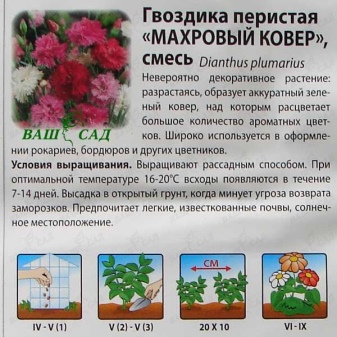

Plume:
- another name is musky;
- maximum height - up to 50 cm;
- flowering terry type;
- spicy, strong aroma;
- varied colors.

Sandy:
- rather miniature, up to 30 cm;
- feather-type petals, fringed;
- unpretentious, loves the sun;
- great for decorating curbs, alpine slides, retaining walls.
Herb:
- low bushes, up to 25 cm in height;
- foliage of an elongated type of rich green tone;
- there may be a reddish tint on the leaves;
- the variety of colors includes scarlet specimens with a dark rim, dark pink, carmine, with light variegation;
- within this species, many varieties and hybrids have been bred.
A very beautiful representative of this group is the Moulin Rouge. This vibrant blend has an incredible delicate scent and a beautiful pink color. It blooms very profusely, suitable for decorating mixborders, borders, garden paths.
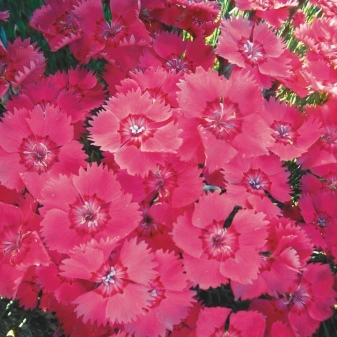

Dutch:
- non-capricious, showy plant;
- bloom with terry, large;
- a lot of greenhouse varieties;
- high degree of decorativeness;
- suitable for decorating any landscape elements.


The series "Lilipot mix" is distinguished, which includes a number of multi-colored mini-carnations. Distinctive features:
- maximum height 25 cm;
- type of bush - branched;
- there is no need for pinching;
- different color;
- you can purchase a separate variety or mix;
- Terry flower, large.
Among the varieties of the series are especially popular: "Scarlet" - white, lavender pink, light purple, orange, lilac and yellow carnations. "Scarlet" is a low bush carnation with a spectacular color, in the center with a raspberry and delicate pink border, decorated with a fringe.
Hybrid dwarf carnation species are also extremely common.
- "Breath of Love" - a rather high grade, about 40 cm, laconic flowering, petals have an uneven color, narrow type, dissected, delicate aroma;
- "Spring Beauty" - maximum height - up to 30 cm, flowering with terry, pink tint, pronounced aroma;
- "White Lediz" - maximum height 25 cm, snow-white bloom, petals with terry, scalloped edging, strong aroma;
- "Sam Barlow" - snow-white inflorescences, contrasting cup, brown, pronounced smell;
- "Shabo" is a spectacular hybrid subspecies with large flowers, can be with double or semi-double, varied color: pink, yellow, red, snow-white.


Shining stars of Leptosyphon
Leptosiphon is an annual ground cover that combines highly decorative foliage and surprisingly touching flowering. Despite the fact that in many ways this plant is modest, it invariably stands out against the background of even the most catchy annuals. Leptosiphon cannot be overshadowed even by a company of petunias, and it is unnecessary to talk about perennials.
In height, tiny leptosiphons will not exceed 10-15 cm, but for all the modestness of their size, very few annuals can compete with them in the ability to grow in breadth. Leptosiphons form a pillow, constantly seize new territory, without infringing upon any, even the smallest, plant and deftly "crushing" them. Leptosiphon itself is not at all aggressive, rather, on the contrary: partners that grow too intensively will easily suppress it. Forming a delightfully dense carpet, Leptosiphon seems to spread luxurious fabrics in the garden.
Its leaves are needle-like, reminiscent of dill, but grow much thicker. Thanks to the dense branching in the density of arrangement, the thin leaves create the strikingly beautiful textures of the green pillow. And the special beauty of the textural spots created by the greenery of the plant is added by bright pubescence: the leaves of Leptosyphon are decorated with numerous villi. The color of the foliage of leptosyphons varies depending on the soil. Classic leptosyphons are distinguished by a light, herbaceous color, but if you plant a plant in a poor soil so beloved by them, then the solid curtains will turn into a spectacular gray-green, with a bluish tint.
Against a luxurious and bright background of grassy-green, fairly light leaves, flowers literally flash during flowering. Thanks to the star-shaped shape, they really seem to be scattered by someone's caring hand. If the leptosyphon is comfortable to grow on the chosen site, the rugs are covered with stars surprisingly densely, often leaves are almost completely hidden under the flowers. Leptosyphon bloom begins in June, and reaches its peak exactly in the middle of the calendar summer.
After a violent flowering, there is a pause, and the second wave of flowering begins only at the end of August and September and is much shorter. In order for leptosyphons to bloom continuously, it is necessary to adjust the timing of sowing and planting, to combine several "generations" of leptosyphon in planting, blooming at different times.
The color palette of Leptosyphon is a separate pride of the plant. After all, flowers of completely different colors bloom on the bush at the same time. But at the same time, Leptosyphon does not look like a variegated and flashy plant.Soft shades of orange, pink, yellow, skillfully shaded with shining white, you cannot call anything other than porcelain.
Despite the complex botanical classification, which makes leptosyphons and gilia (gilia) related, and some species with linanthus (linanthus), the plant is easily recognizable and original, it is distributed and grown under one name - leptosyphons
The presence of more than 25 separate natural species is rather important from a scientific point of view and for the protection of endemics, because all cultivated as decorative leptosyphons are distributed under a common name without mentioning the species and are hybrids or selective forms
Improved, selectively bred leptosyphons are found in almost every country and even region. When buying seeds, it is better to focus on purely decorative merits, in particular on the color palette. But there are already legendary mixtures of multi-colored leptosyphons - "Confetti Mixture", "Stardust" and "French Hybrids".
 Leptosiphon androsaceus. anniesannuals
Leptosiphon androsaceus. anniesannuals
In garden design, Leptosyphon is used:
- as one of the best plants for emergency design, filling voids, bald spots;
- in the role of a concealer of the shortcomings of compositions and free soil on flower beds and in flower beds;
- as a great plant for patterned mixborders with a play of textures;
- as a colorful annual ground cover;
- as one of the most spectacular annuals for decorating alpine slides and rockeries, creating natural transitions and soft spots;
- in the design of chintz flower beds and flower beds;
- as a unique curb plant.
The best partners for Leptosyphon are: Herbal Clove, Osteospermum, Clarkia, Iberis.
7.Species of Iberis:
7.1 Iberis umbrella - Iberis umbellata
The most common type of Iberis in floriculture, originating from the Mediterranean. It is an annual herb with branched shoots, on which are located green, lanceolate leaves. During the flowering period, forms rounded apical, corymbose inflorescences with white, lilac or pink buds. The flowers consist of 4 - 5 oblong petals of different sizes. Reaches a height of 30 cm, blooms in spring.
7.2 Iberis bitter - Iberis amara
Annual herbaceous plants that are often used in homeopathy. The flower is used in the treatment of diseases of the upper respiratory tract, heart failure and diseases of the digestive system. Plants reach a height of 15 - 30 cm, the flowering period begins in the second half of summer. The natural habitat is located in the Iberian Peninsula - in Spain and Portugal.
7.3 Iberis evergreen - iberis sempervirens
This species is also very popular in horticulture, it is a South European perennial shrub with erect or lodging shoots. Plant height can reach 30 cm, flowering period begins in spring.
7.4 Iberis gibraltar
A short flowering perennial that is often used as a groundcover or grown on the rocky slopes of alpine hills. This plant originates from North Africa, during the flowering period it forms umbrella-shaped inflorescences up to 8 cm in diameter with white or lilac buds.
7.5 Iberis ever flowering - Iberis semperflorens
An evergreen flowering perennial shrub native to Italy. Plants are impressive in size - the shoots of this species can reach a height of about 70 cm. Flowering is not abundant, but individual inflorescences - scutes can form over a long period of time from spring to early autumn.
7.6 Rocky Iberis - Iberis saxatilis
A miniature species that has lodging, easily rooted shoots when in contact with the ground, not exceeding 7 - 20 cm in height. This is an excellent ground cover plant with a very early flowering period - the first buds can bloom after the snow cover melts.This species originates from the Mediterranean.
7.7. Crimean Iberis - Iberis simplex, Iberis taurica
Perennial shrub up to 12 - 15 cm high with creeping shoots and alternately arranged narrow leaves. During the flowering period, which begins in late spring, this species adorns itself with rounded inflorescences - umbrellas with numerous lilac buds.
7.8. Iberis pinnate - Iberis pinnata
An attractive flowering annual that reaches a height of 10 to 30 cm. From May to July, the plant forms snow-white, friable inflorescences. The species became widespread in the Iberian Peninsula.
Interesting Facts
In Spain, the carnation flower was the subject of a secret rendezvous. The lady chose a certain color of the flower, fastened it to her chest. Thus, the gentleman knew the meeting place by the color of the flower. In Japan, lush carnation is a symbol of the village of Kawakita and one of the country's 7 traditional flowers. The expression "yamato-nadesiko" is formed by the hieroglyphs "yamato", which means "nationalism of Japan", and "nadesiko" - "lush carnation." In general, it means the ideal of a Japanese woman in a traditional society.
In general, lush carnation is an unpretentious and easy-care plant. Delicate flowers are like feathers, they will decorate your garden or windowsill. Ideal for decorating an alpine slide or balcony. A bouquet of this carnation will be a gorgeous gift. The main thing is to provide the plant with the necessary care, and it will delight you with its wonderful aroma and abundant flowering.
See below for proper carnation care.
Peculiarities
Carnation herb is a herbaceous plant that grows both in natural conditions and with the help of human cultivation. This culture is perennial, like other representatives of the carnation family, it is distinguished by its ground cover, and without proper care it quickly loses its decorative effect, abundantly growing on the ground. The description of herbal clove has a number of features.
- A variety of colors of petals in different plant varieties. The most common are white, pink and red representatives, as well as two-tone options.
- The flower has 5 petals, the edges of which are serrated, like other plants from the carnation family.
- The stems can have flower stalks or grow without them. The second variety is smaller and grows smaller than the first.
- The leaves are narrow in shape and can be represented by the entire color palette of green.
- The root system develops to the sides, and not deep into the soil, because the roots are short and can hold the plant well on the slopes of mountains and hills.
- After the completion of the flowering process, a box with seeds is formed in place of the flower.
Reproduction of leptosyphon
This plant can only be propagated by seed. But the strategy for growing leptosyphon can be different. It is better to divide the seeds into several seeding waves. This will allow you to get continuously flowering compositions and stretch the flowering of Leptosyphon for a much longer period. Leptosiphon also forms self-seeding, but the seeds that have undergone stratification in the soil mutate and the plant will produce flowers of only one color - yellow or white.
Leptosyphon can be sown directly into the soil very early, back in April, because it is not sensitive to spring frosts even at a very early age. The soil at the growing site must be carefully leveled and moistened. Spread the seeds only on the surface, slightly covering them with soil, but not deeply deepening.
Leptosyphon is sown on seedlings from April to the end of May. Sowing for seedlings is best done not in the substrate, but in wet sand, scattering the seeds over the surface. At an air temperature of 20 degrees and covered with foil or glass, seedlings will appear quite quickly. It is better to dive plants at the stage of 3-4 leaves, and they can be transferred to the soil only in May.The distance when planting seedlings between plants should be about 20 cm.
It is better not to destroy the soil clod around the plants, thus keeping even the smallest roots intact. After planting, the seedlings need to provide frequent and abundant watering until they fully adapt and resume growth.




